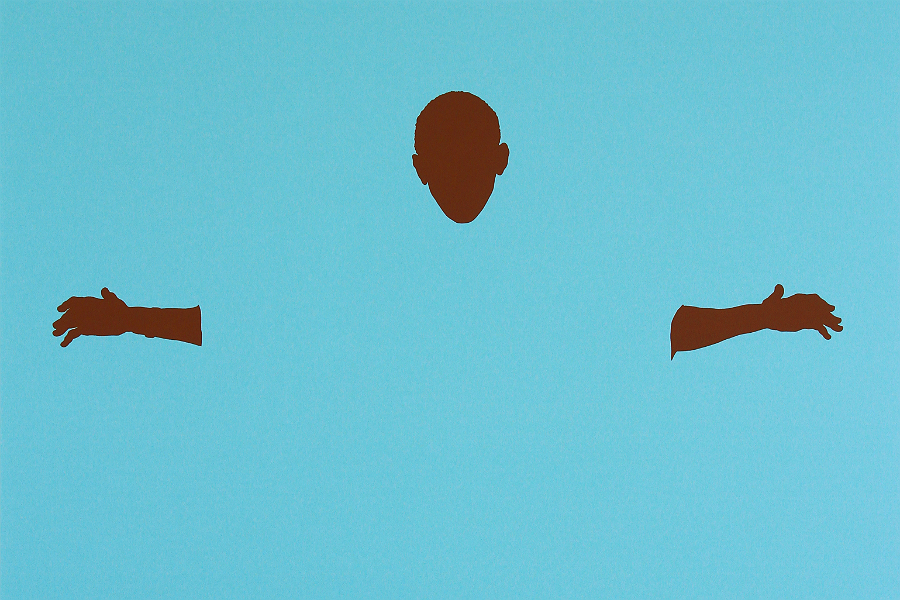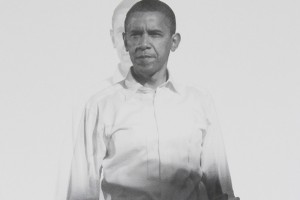Emptiness For President

In Seven Days is an exhibition purporting to tell the story of Barack Obama’s 2008 election campaign. C James Fagan argues there’s more to it than that…
Have you ever read Don deLillo’s White Noise? Well, in it the main character and his friend visit ‘The Most Photographed Barn in America’. The protagonist’s friend details how the action of visiting the barn and taking photographs is more important than the actual barn, that this activity has overridden any meaning that the barn may ever have held. In a sense the barn does not exist.
This is my clumsy attempt to describe the process of Simulacra, which is on my mind as I look into one of seven vitrines that form part of Nicola Green’s In Seven Days exhibition at the Walker. Each vitrine contains images, reproductions of the face of Barack Obama, collected during Obama’s 2008 presidential campaign. The images pile up, reflect each other, affirm and cancel each other out. They lay there and ask the question: in a world of hyper-reproduction, can such a confluence of imagery represent one person?
The sense of simulacra (or at least my faltering understanding of it) is compounded by the role of president itself. This role of ‘Most Powerful Man in the World’ seems to owe much to a mythology created and promoted by films and TV; the role of president is to provide a symbol for America. Regarding it in this way, it’s not such a leap to thinking that anybody running for president is auditioning for a role.
America is a land rich in self-mythology, from the pilgrims fleeing Europe; the settlers fighting nature; through to the cowboy, it’s been a mythology of the individual overcoming obstacles in order to meet their manifest destiny. The role of president isn’t immune to this. Through history there seems to be examples of the heroic president fighting against great odds, such as Washington and Lincoln. This may set a precedent for presidents to leave a mark, but where does this idea of ‘The world’s Most Powerful Man’ come from?
Where and when this concept originated from is hard to pinpoint. It could be argued that it is a concept that belongs to the latter half of the 20th Century, with the increasing presence of visual media. To my mind the first politician to embrace this visual age would be John F Kennedy. Building a campaign based on his war heroics, a period recounted in the film PT-109, he tapped into the image of America as a young country poised to take over from a battered Europe. This image helped him defeat Nixon, after a now infamous TV debate.
Kennedy also ushered in the soundbite, offering short authoritative speeches to inform the electorate that he is the one who is in control and can get things done. Or at least provide the impression that he is that man. Of course there is the small fact that Kennedy and the presidents that followed actually were some of the most powerful men in the world. After all, they do have nuclear Armageddon at their fingertips.
One of Kennedy’s legacies was a creation of a caricature of a modern leader; he became the template for contemporary politicians. This caricature is also reflected in films where America’s leaders often become (young) fist fighting types, as illustrated by Air Force One (Harrison Ford) and Independence Day (Bill Pullman). Or they have the quiet dignity and gravitas of Morgan Freeman’s president in Deep Impact. The flipside of the Kennedy caricature is the corrupt, womanizing Mayor Quimby of the Simpsons.

How does any of this apply to Obama? Well it may sound cynical; he understands his role in that he grasps that he must pose himself to the role of leader. Though the image provided by Obama would seem to be of strong, benign leader. While writing this I think about that image of Obama watching the death of Bin Laden, where he appears pensive, concerned with no sign of triumphalism. Also think about his reactions to Hurricane Sandy and Sandy Brook; they were everything we would expect from a statesman. The ultimate 21st century politician, or as one unnamed plumber put it ‘He makes you feel like he’s not a politician but a leader.’
What should we expect, would we react the same to someone who is pragmatic? We have an image of a leader being strong and decisive, charging into danger. While at the same time being able to understand the people under their command, how long has this image been with us? Probably since ancient history, so these ideas are pretty ingrained. Anybody who attempts to become a leader is entering into a pact where they must enact this role, become an image of a concept.
Still there is something shifting at the centre of a presidential image. It’s like the double exposed Gerhard Richter-esque Obama (above) which makes up one of the seven screen prints which conclude this exhibition. Everything is clear and obscured at the same time. Only it feels wrong to consider them a conclusion, rather than as graphic representations, a distillation of Nicola Green’s experience of the Obama campaign. Through that I begin to see a singular truth, a truth of subjective experience, one which our preconceptions allow us to share. Or at least to recognise and understand.
Somehow, by collecting these images of Obama in these vitrines, Green is engaged in a process of understanding our relationship and reaction to symbols and what they stand for; it is an abstract world which makes me consider, in this world of simulacra, that it is experience of the world that makes it real. On leaving the exhibition I realise that it raised certain questions regarding the image and our experience of the world and how artists, image-makers, are able to communicate this in the 21st century. I don’t know if this was the intent of the exhibition but it was my experience of it and to follow my argument, my truth.
C James Fagan
In Seven Days…by Nicola Green continues at the Walker Art Gallery until the 14th of April





